Unit 3 War and peace Starting out & Understanding ideas 课件(共28张,内嵌视频)
文档属性
| 名称 | Unit 3 War and peace Starting out & Understanding ideas 课件(共28张,内嵌视频) |  | |
| 格式 | pptx | ||
| 文件大小 | 18.8MB | ||
| 资源类型 | 教案 | ||
| 版本资源 | 外研版(2019) | ||
| 科目 | 英语 | ||
| 更新时间 | 2025-04-28 20:47:25 | ||
图片预览

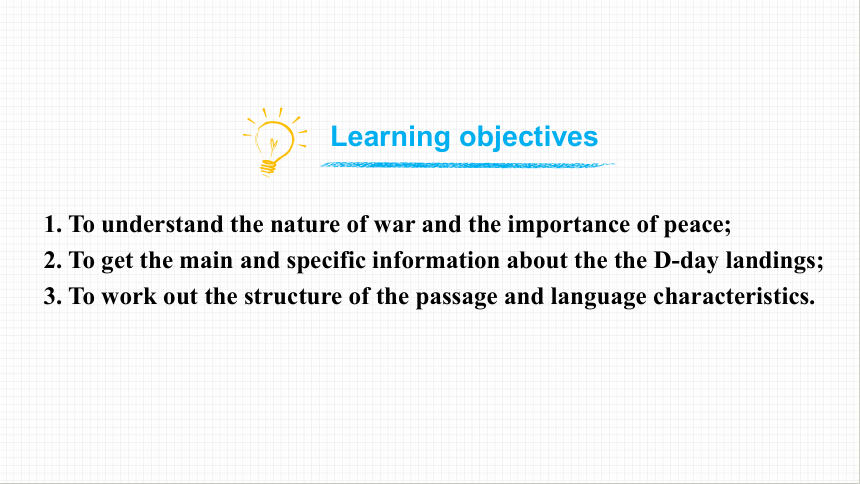
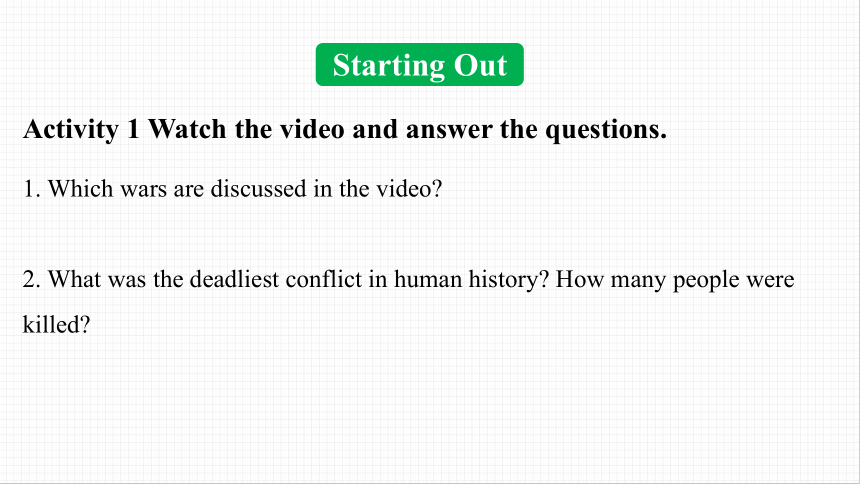
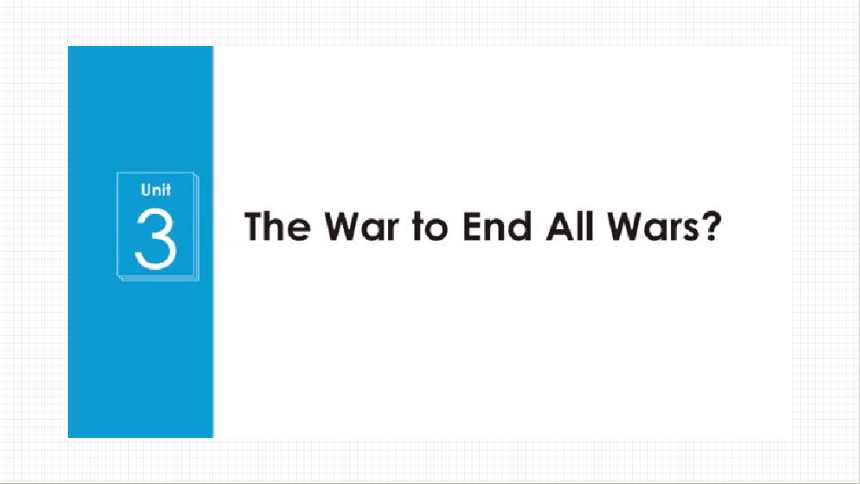
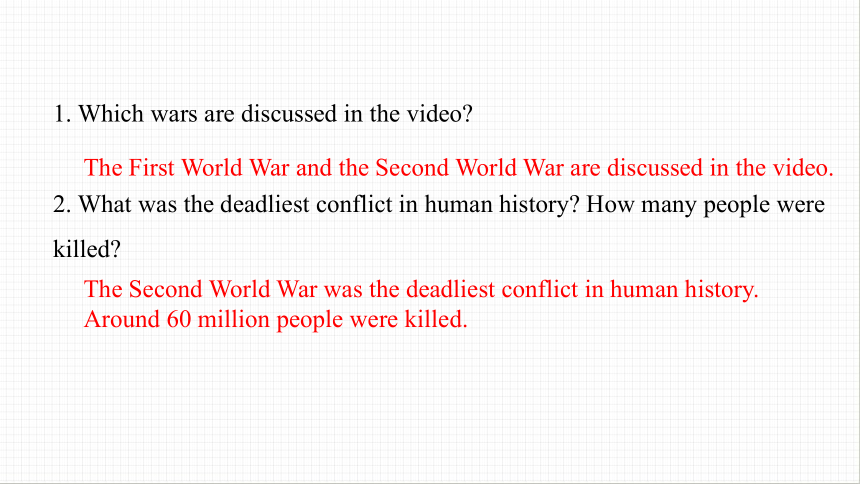
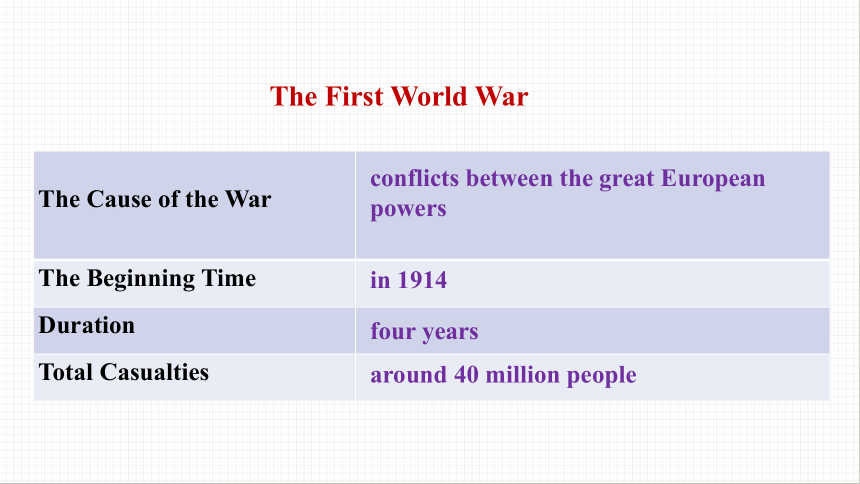
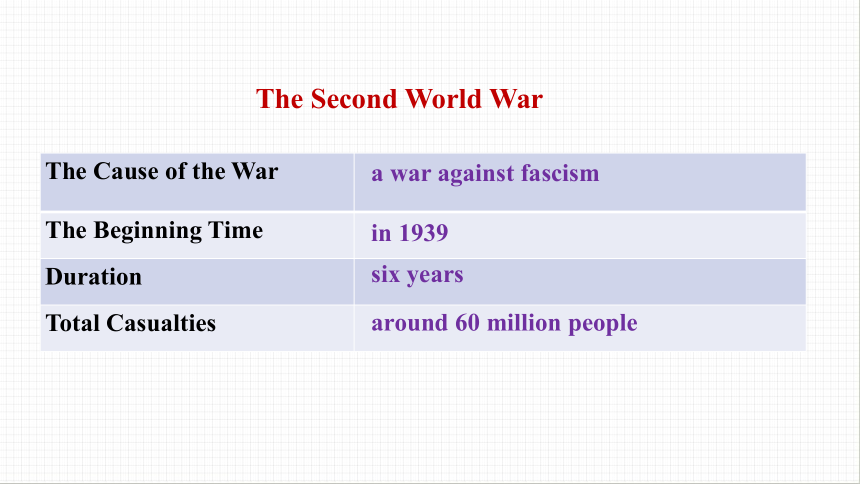
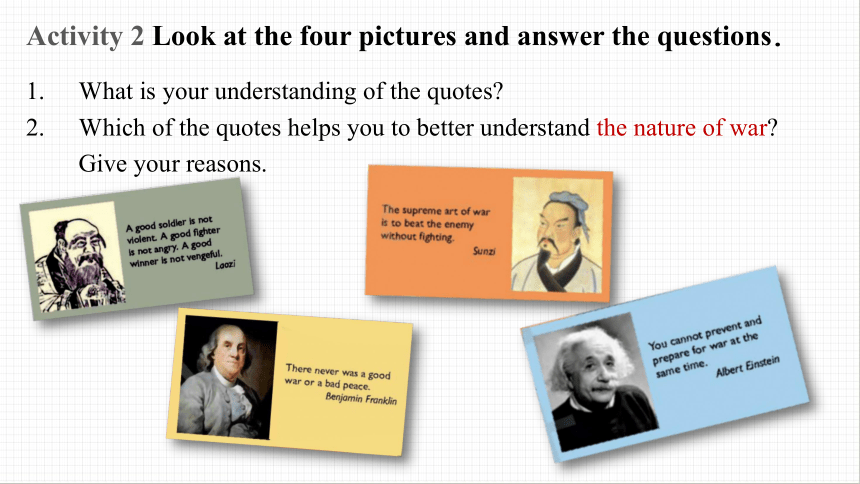
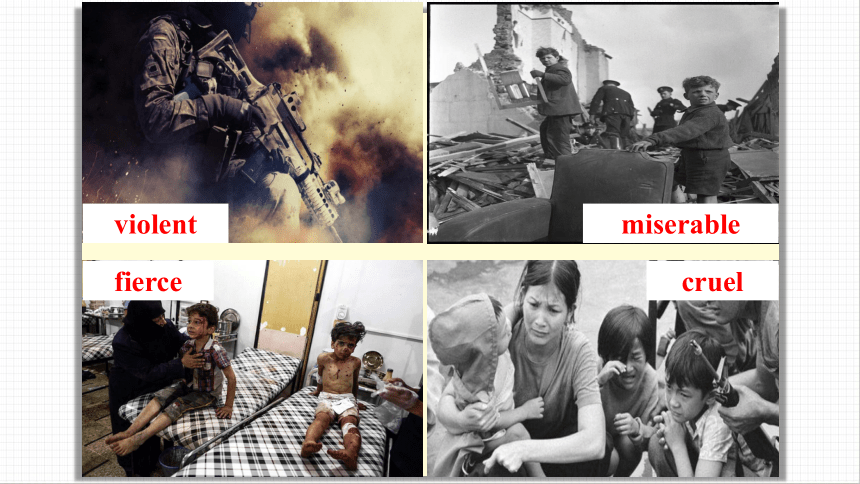
文档简介
Unit 3 War and Peace
Starting Out&Understanding Ideas
Learning objectives
1. To understand the nature of war and the importance of peace;
2. To get the main and specific information about the the D-day landings;
3. To work out the structure of the passage and language characteristics.
Starting Out
Activity 1 Watch the video and answer the questions.
1. Which wars are discussed in the video?
2. What was the deadliest conflict in human history? How many people were killed?
1. Which wars are discussed in the video?
2. What was the deadliest conflict in human history? How many people were killed?
The First World War and the Second World War are discussed in the video.
The Second World War was the deadliest conflict in human history. Around 60 million people were killed.
{5C22544A-7EE6-4342-B048-85BDC9FD1C3A}
The Cause of the War
The Beginning Time
Duration
Total Casualties
The First World War
conflicts between the great European powers
in 1914
around 40 million people
four years
{5C22544A-7EE6-4342-B048-85BDC9FD1C3A}The Cause of the War
The Beginning Time
Duration
Total Casualties
The Second World War
around 60 million people
six years
in 1939
a war against fascism
Activity 2 Look at the four pictures and answer the questions.
What is your understanding of the quotes?
Which of the quotes helps you to better understand the nature of war? Give your reasons.
violent
miserable
fierce
cruel
Answer the following questions.
1. What was the deadliest conflict in human history?
2. What is your opinion on war? Come up with three words or expressions to help express your opinion.
The Second World War.
The war is frightening, cruel and bloody. (inhuman, violent, tragic …)
Pre-reading
Understanding Ideas
There never was a good war or a bad peace.
— Benjamin Franklin
Look at the picture and the map and answer the questions.
1. What do you think the picture and the map show?
2. What do you expect to read about in the passage? Share your ideas with the class.
在军事活动中,D是Day的首字母,往往用D-Day表示某个行动的日期(进攻或撤退的启动日)。D-Day landing意思是行动日登陆,标题用的是时间而不是诺曼底这个地点。
发生在1944年6月6日6时30分,是第二次世界大战中盟军在欧洲西线战场发起的一场大规模攻势,这次行动的日期1944年6月6日被称为“D-DAY”。
诺曼底登陆战役
The Normandy Landings
1. What’s the style(文体) of this passage?
A. narration
B. argumentation
C. exposition
2. What’s the order of the passage?
3. How many parts this passage can be divided?
Task1:Read for stucture
Time order
Before the WWⅡ
During the WWⅡ
After the WWⅡ
1. The outcome of the operation
2. The background information of the operation
3. The severe casualties(伤亡人数) on Omaha Beach
4. The everlasting memory of the soldiers’ brave actions
5. The initial stage of the operation
6. The order issued by the Supreme Allied Commander before the operation
7. The 70th anniversary of the D-Day landings
Match the main ideas to the paragraphs and give your reasons
Organise information from the passage and complete the fact file.(P37)
The D-Day landings
Date: ______________
Place: ___________________________
Aim of the operation: _____________________________________________________
________________________________________
Supreme Allied Commander: _______________________
6 June 1944
the Normandy beaches
to reach the Normandy beaches along about 80 kilometres of
French coastline
General Eisenhower
Timeline of the operation:
Spring 1944 Allied troops _________________________
6 June 1944
Start of _________________________
dawn: thousands of troops were journeying across ________________________________
mid-morning: hundreds of soldiers ___________________________________________________
the Normandy landings
the English Channel to Normandy
lay dead in the water and amongst the tanks on the beach
gathered in large numbers.
August 1944
The Allies liberated Paris and the Germans
__________________________________________
Outcome of the operation:
____________________________________________________________________________________________________________
______________________________________________________
despite the high cost in human life, the D-Day landings were a success and were seen widely as the beginning of the
end of Second World War
were removed from northwest France.
Para1. Fill in the blank.
Aim:____________________________
Reason:___________________________
Code –name:_______________________
Allied troops:_______________________
Place:____________________________
Date:____________________________
Background
WWⅡ raging across the globe for 5 years
to free north-west Europe from German
occupation
Operation Overlord
British, Canadian and American soldiers
the south coast of England
6th June
( perfect combination of
weather, moon & tides)
rage v. 肆虐;猖獗
代号为“霸王计划”
Para2.
An order issued by Supreme Allied Commander General Eisenhower to the troops read: “Your task will not be an easy one. Your enemy is well trained, well equipped and battle-hardened… But this is the year 1944… The tide has turned! The free men of the world are marching together to Victory! I have full confidence in your courage, devotion to duty and skill in battle. We will accept nothing less than full Victory!”
潮流已经逆转! (比喻战争形势逆转)
Para.4
The fiercest fighting was at Omaha Beach. The enemy were hiding, ready to attack the Allied soldiers even before they reached land. Boats were hit and men drowned, while those who did make it to the beach faced heavy machine gunfire. By mid-morning, hundreds lay dead in the water and amongst the tanks on the beach.
到了上午十点左右已有数百人在水里或海滩上的坦克之间阵亡。
Translation
Para.6
They shall grow not old, as we that are left grow old:
Age shall not weary them, nor the years condemn.
At the going down of the sun and in the morning
We will remember them.
...As part of this solemn and moving occasion, a former soldier read out to the crowd these lines from the poem For the Fallen, by Laurence Binyon:
For the Fallen 是英国诗人 Laurence Binyon(1869-1943) 于1914 年 9 月在英国的《泰晤士报》上发表的诗歌。该诗歌表达了作者对阵亡将士的缅怀之情,广为流传。诗歌的第三段和第四段(尤其是第四段)已经跨越了国界,成为缅怀阵亡将士的著名挽词。课文中摘选的就是第四段。
他们永远不会老去,而我等生者日渐衰老:
他们永远不为耄耋所难,永远不为残年所累。
每当太阳落下,每当清晨来临,
我们就会想起他们。
1. What is the historical significance of the D-Day landings?
2. What is your understanding of the poem For the Fallen?
3. How can you use the language you have learnt to describe another event during the Second World War? Share your ideas with the class.
Think and share
Now think about how the author of the passage presents historical facts to a powerful effect.
Post-reading
1. What is the historical significance of the D-Day landings?
The D-Day landings were the largest combined sea, air and land operation in history. The operation was seen widely as the beginning of the end of the Second World War.
2. What is your understanding of the poem For the Fallen?
They shall grow not old, as we that are left grow old:
Age shall not weary them, nor the years condemn.
At the going down of the sun and in the morning,
We will remember them.
他们永远不会老去,而我等生者日渐衰老:
他们永远不会为老年所难,永远不会为残年所累。
当太阳落下,清晨来临,
我们会永远缅怀他们。
3. How can you use the language you have learnt to describe another event during the Second World War? Share your ideas with the class.
Students’ own answers.
Starting Out&Understanding Ideas
Learning objectives
1. To understand the nature of war and the importance of peace;
2. To get the main and specific information about the the D-day landings;
3. To work out the structure of the passage and language characteristics.
Starting Out
Activity 1 Watch the video and answer the questions.
1. Which wars are discussed in the video?
2. What was the deadliest conflict in human history? How many people were killed?
1. Which wars are discussed in the video?
2. What was the deadliest conflict in human history? How many people were killed?
The First World War and the Second World War are discussed in the video.
The Second World War was the deadliest conflict in human history. Around 60 million people were killed.
{5C22544A-7EE6-4342-B048-85BDC9FD1C3A}
The Cause of the War
The Beginning Time
Duration
Total Casualties
The First World War
conflicts between the great European powers
in 1914
around 40 million people
four years
{5C22544A-7EE6-4342-B048-85BDC9FD1C3A}The Cause of the War
The Beginning Time
Duration
Total Casualties
The Second World War
around 60 million people
six years
in 1939
a war against fascism
Activity 2 Look at the four pictures and answer the questions.
What is your understanding of the quotes?
Which of the quotes helps you to better understand the nature of war? Give your reasons.
violent
miserable
fierce
cruel
Answer the following questions.
1. What was the deadliest conflict in human history?
2. What is your opinion on war? Come up with three words or expressions to help express your opinion.
The Second World War.
The war is frightening, cruel and bloody. (inhuman, violent, tragic …)
Pre-reading
Understanding Ideas
There never was a good war or a bad peace.
— Benjamin Franklin
Look at the picture and the map and answer the questions.
1. What do you think the picture and the map show?
2. What do you expect to read about in the passage? Share your ideas with the class.
在军事活动中,D是Day的首字母,往往用D-Day表示某个行动的日期(进攻或撤退的启动日)。D-Day landing意思是行动日登陆,标题用的是时间而不是诺曼底这个地点。
发生在1944年6月6日6时30分,是第二次世界大战中盟军在欧洲西线战场发起的一场大规模攻势,这次行动的日期1944年6月6日被称为“D-DAY”。
诺曼底登陆战役
The Normandy Landings
1. What’s the style(文体) of this passage?
A. narration
B. argumentation
C. exposition
2. What’s the order of the passage?
3. How many parts this passage can be divided?
Task1:Read for stucture
Time order
Before the WWⅡ
During the WWⅡ
After the WWⅡ
1. The outcome of the operation
2. The background information of the operation
3. The severe casualties(伤亡人数) on Omaha Beach
4. The everlasting memory of the soldiers’ brave actions
5. The initial stage of the operation
6. The order issued by the Supreme Allied Commander before the operation
7. The 70th anniversary of the D-Day landings
Match the main ideas to the paragraphs and give your reasons
Organise information from the passage and complete the fact file.(P37)
The D-Day landings
Date: ______________
Place: ___________________________
Aim of the operation: _____________________________________________________
________________________________________
Supreme Allied Commander: _______________________
6 June 1944
the Normandy beaches
to reach the Normandy beaches along about 80 kilometres of
French coastline
General Eisenhower
Timeline of the operation:
Spring 1944 Allied troops _________________________
6 June 1944
Start of _________________________
dawn: thousands of troops were journeying across ________________________________
mid-morning: hundreds of soldiers ___________________________________________________
the Normandy landings
the English Channel to Normandy
lay dead in the water and amongst the tanks on the beach
gathered in large numbers.
August 1944
The Allies liberated Paris and the Germans
__________________________________________
Outcome of the operation:
____________________________________________________________________________________________________________
______________________________________________________
despite the high cost in human life, the D-Day landings were a success and were seen widely as the beginning of the
end of Second World War
were removed from northwest France.
Para1. Fill in the blank.
Aim:____________________________
Reason:___________________________
Code –name:_______________________
Allied troops:_______________________
Place:____________________________
Date:____________________________
Background
WWⅡ raging across the globe for 5 years
to free north-west Europe from German
occupation
Operation Overlord
British, Canadian and American soldiers
the south coast of England
6th June
( perfect combination of
weather, moon & tides)
rage v. 肆虐;猖獗
代号为“霸王计划”
Para2.
An order issued by Supreme Allied Commander General Eisenhower to the troops read: “Your task will not be an easy one. Your enemy is well trained, well equipped and battle-hardened… But this is the year 1944… The tide has turned! The free men of the world are marching together to Victory! I have full confidence in your courage, devotion to duty and skill in battle. We will accept nothing less than full Victory!”
潮流已经逆转! (比喻战争形势逆转)
Para.4
The fiercest fighting was at Omaha Beach. The enemy were hiding, ready to attack the Allied soldiers even before they reached land. Boats were hit and men drowned, while those who did make it to the beach faced heavy machine gunfire. By mid-morning, hundreds lay dead in the water and amongst the tanks on the beach.
到了上午十点左右已有数百人在水里或海滩上的坦克之间阵亡。
Translation
Para.6
They shall grow not old, as we that are left grow old:
Age shall not weary them, nor the years condemn.
At the going down of the sun and in the morning
We will remember them.
...As part of this solemn and moving occasion, a former soldier read out to the crowd these lines from the poem For the Fallen, by Laurence Binyon:
For the Fallen 是英国诗人 Laurence Binyon(1869-1943) 于1914 年 9 月在英国的《泰晤士报》上发表的诗歌。该诗歌表达了作者对阵亡将士的缅怀之情,广为流传。诗歌的第三段和第四段(尤其是第四段)已经跨越了国界,成为缅怀阵亡将士的著名挽词。课文中摘选的就是第四段。
他们永远不会老去,而我等生者日渐衰老:
他们永远不为耄耋所难,永远不为残年所累。
每当太阳落下,每当清晨来临,
我们就会想起他们。
1. What is the historical significance of the D-Day landings?
2. What is your understanding of the poem For the Fallen?
3. How can you use the language you have learnt to describe another event during the Second World War? Share your ideas with the class.
Think and share
Now think about how the author of the passage presents historical facts to a powerful effect.
Post-reading
1. What is the historical significance of the D-Day landings?
The D-Day landings were the largest combined sea, air and land operation in history. The operation was seen widely as the beginning of the end of the Second World War.
2. What is your understanding of the poem For the Fallen?
They shall grow not old, as we that are left grow old:
Age shall not weary them, nor the years condemn.
At the going down of the sun and in the morning,
We will remember them.
他们永远不会老去,而我等生者日渐衰老:
他们永远不会为老年所难,永远不会为残年所累。
当太阳落下,清晨来临,
我们会永远缅怀他们。
3. How can you use the language you have learnt to describe another event during the Second World War? Share your ideas with the class.
Students’ own answers.
